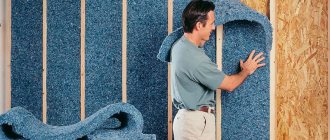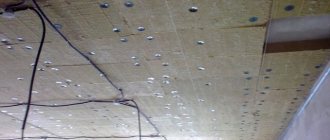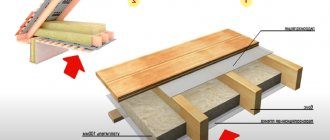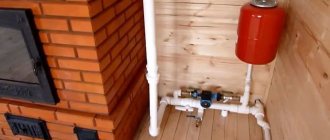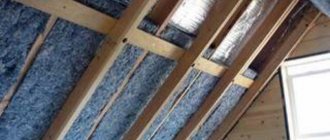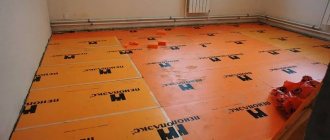Purpose of interventional insulation
Inter-crown insulation is a special type of heat-insulating materials that are laid between the crowns of a wooden building (house, bathhouse, utility room) to eliminate gaps. They can be loose (tow, moss) or in the form of ribbons (felt, batting).
The main task of such insulation is to create comfortable living conditions inside the house. Interventional insulation creates a favorable microclimate only if it can:
- keep the house warm in winter and prevent it from overheating in summer;
- avoid drafts;
Insulation of a log house with moss.
- compensate for changes in the linear dimensions of wood that appear during drying or swelling during changes in environmental humidity (so that cracks do not appear);
- protect owners from unnecessary noise;
- prevent insects from appearing in the house;
The main functions of interventional insulation.
- prevent the colonization of inter-crown space by microorganisms.
In order to perform its assigned functions, inter-crown insulation for timber (logs) must have a certain set of quality characteristics.
Final Recommendation
By the way, recently (on the eve of the New Year) a fellow colleague of mine bought flax-jute fabric at. He liked the conversation with the consultant (in his words, he understands issues of wooden house construction very well) and the price of the product was quite reasonable. This is not an advertisement - just a consultation, which is always useful. I recommend this company for residents of Moscow and the Moscow region. Moreover, the company is specialized and has been on the construction market for several years.
Well, perhaps he said everything he wanted. If it was informative, then do not miss the release of new information. Do you have friends who are building a bathhouse or a house? Recommend the article to them.
Good luck and warm, well-caulked walls. Bye!
Quote of wisdom: This is how men are made: they can resist the smartest arguments and cannot resist a single glance (Bazzak).
Operational Requirements
High-quality insulation for the crowns of a wooden house must have:
- low level of thermal conductivity to ensure minimal heat loss - the best performance for natural materials;
- high vapor permeability - the walls must breathe, ensuring natural air exchange between the street and the room;
- the ability to absorb moisture well and quickly release it (dry), which allows you to maintain the same moisture content of the timber or log around the entire circumference (the processes of the occurrence of multidirectional stresses inside the timber, leading to its cracking, and the appearance of mold (rot) between the crowns are eliminated). The best in this indicator are flax and jute, but synthetic heat insulators do not absorb liquid - it remains on the fibers. Therefore, artificial insulation materials are not used in bathhouses - the walls will begin to rot;
- uniform density - there will be no cold bridges;
- high elasticity, which allows you to tightly close the gap between the crowns when the house shrinks and the walls swell or dry out;
- resistance to fungus and mold;
- resistance to ultraviolet radiation (sun) and the vagaries of nature (rain, snow, heat, frost);
- long service life comparable to the durability of a house;
- optimal ratio between thickness and density (indicators are given in Table 1);
Table 1. Optimal ratio of thickness and density.
| Thickness, mm | Density, g/m2 |
| 5 | 400 |
| 6-7 | 600 |
| 8-10 | 600-700 |
| 10-15 | 800 |
- environmentally friendly - does not contain components harmful to health;
- sufficient tape width. There are 2 rules here.
- At frost temperatures of -20oC, the width of the thermal insulator should be at least 10 cm, -30oC - 12 cm or more, -40-50oC - 14-18 cm.
- Insulation that is 5 mm smaller in width than the groove will help you get a beautifully designed inter-crown space. If further insulation of the gap is planned with the same material (caulking), the tape should be 10-15 cm larger than the contact area of the crowns.
Modern tape inter-crown insulation
The most important advantage of tape insulation is its high manufacturability, which ensures ease of work. Tape materials used to seal inter-crown cracks can be divided into two types: linen and jute. According to the manufacturing method, they are all divided into combed and needle-punched (that is, additionally stitched).
Intercrown tape insulation can be laid in the groove of a timber or log in three ways:
a) Laying insulation without bends b) Laying insulation with a one-sided bend c) Laying insulation with a double-sided bend
Two types of sealants are made from flax: linen tape tow and linen felt. These materials have good thermal insulation properties, the ability to absorb, but at the same time quickly release moisture; are not affected by fungus and moths. The thermal conductivity coefficient of linen insulation is 0.034 W/(m•ºС). In the production of flax tow, the flax fiber is cleaned from kernels (the destroyed woody part of the flax stem) and foreign impurities on a carding machine. During operation, the flax fibers are polarized in the longitudinal direction, and a tape 15 cm wide is formed from them. Thus, the advantages of tape flax tow over conventional construction tow are obvious: the flax fiber is cleared of impurities, the tape lies in an even layer, the required amount of insulation is easy to calculate.
To complete the finishing, sometimes a decorative rope made of flax or jute is laid along the crown seam.
Linen felt is made using needle-punched technology. During the production process, flax fibers are pierced with special jagged needles, the fabric is held together with its own fibers, resulting in a dense and uniform material in thickness. Naturally, the question will arise, which of these insulation materials is better? Even though they are both 100% linen, there are certainly differences.
Inter-crown insulation based on flax:
a) linen rope b) flax jute c) Finnish-made Eurolen
The disadvantage of flax tow is that it is made in only one width - 15 cm. This is due to the characteristics of the production equipment. However, this material is loose and elastic, so if necessary, it can be manually compressed or stretched in width.
Linen felt is produced in strips of various widths, and therefore it is more versatile. Felt also has good soundproofing characteristics.
Experts recommend using flax tow when building houses from hand-cut logs and ordinary timber, and flax felt when constructing buildings from rounded logs and profiled timber. The cost of linen tow is almost two times cheaper than linen felt. A roll of tow 60 m long costs 350 rubles, a 20-meter roll of felt 5-6 mm thick costs from 80 to 700 rubles. (depending on the width of the tape).
Linen felt is cut into strips equal to the length of the timber. The width of the material should extend slightly beyond the crown.
, jute-based materials have recently been increasingly used Jute is an annual plant from the linden family, native to India, Bangladesh, China, Egypt and Australia. The advantages of jute fiber include strength and resistance to rotting (due to the high content of lignin, a natural resin that makes the insulation waterproof). The latter quality makes the use of this material particularly advantageous in the construction of baths. Jute also has an undoubted aesthetic advantage that distinguishes it from other inter-crown insulation (sealants) - a golden color, close to the tone of freshly planed wood.
Log house on jute tow
Although many companies working with various types of tape insulation consider jute fiber (especially one that consists of 100% jute) to be the optimal material today, it still has disadvantages.
The timber was laid on jute tow.
Jute fibers, compared to flax fibers, are short and stiff (since they practically lack wax and pectin, which are responsible for elasticity), so jute insulation is coarser, more brittle and less tensile strength. To avoid this, during the production of the material, from 10 to 50% flax is added to jute.
| Environmentally friendly modern tape insulation: linen and flax-jute felt | The process of compacting the grooved groove of a rounded log with flax-jute cloth. The width of the tape is selected depending on the width of the groove. Workers use construction staplers to secure the material. |
In such mixed versions, hard jute fibers serve as the frame, and soft flax serves as the filler. As a result, the material becomes more elastic and less wrinkleable. When flax is added, the color of the products changes. The more flax they contain, the more gray they become.
A roll of tape jute insulation 20 m long.
The jute family is represented by three types of products: jute tow (100% combed jute), jute felt (90% jute, 10% flax) and flax-jute felt (50% jute, 50% flax). These materials are produced in rolls of various widths, so choosing one that matches the diameter of the logs or the width of the timber is not difficult. The cost of a roll of jute tow 60 m long is 400 rubles, jute felt 20 m long - from 100 to 820 rubles. (depending on the width), flax-jute felt 50 m long - from 230 to 500 rubles.
| This is what jute tow looks like | Roll of jute felt |
When choosing a material, experts advise paying attention to its quality. High-quality products use highly purified natural fiber and maintain the parameters of density and density uniformity. In low-quality products, these parameters are violated. Interventional insulation is often produced from substandard raw materials with a high degree of hardness (fiber hardness) and the presence of foreign impurities, which does not allow obtaining a continuous strip of optimal density and can lead to premature destruction of the insulation.
There are quite a lot of myths about tape insulation ; the most common one is this: the use of tape insulation eliminates re-caulking due to the high surface density and uniform thickness of the sheet. The desire of sellers to present their goods in the most favorable light is understandable. But not due to obvious lies? In fact, the shrinkage of flax fiber and jute is up to 5-6% of the original height, that is, 10-15 cm per floor. Consequently, the appearance of inter-crown cracks during settlement of the house is inevitable. Therefore, no matter what kind of insulation you use, you will still have to re-caulk the walls. The only exceptions are buildings built from laminated veneer lumber. Thanks to the features of this wall material (and not the properties of the insulation), settlement is minimal - 1-1.5 cm over the entire height of the wall of a two-story house.
Synthetic insulation
Synthetic thermal insulation for the gaps between the crowns of the wall is represented by polyester fibers. The general advantages of this type of insulation include:
- durability - manufacturers talk about a service life of 100 years;
- low thermal conductivity coefficient;
- vapor permeability;
- elasticity (volume is restored by 90% after prolonged compression);
- frost resistance.
There are two disadvantages:
- high cost of 1 linear meter;
- do not absorb water, as a result of which a greenhouse effect occurs indoors, and the wood becomes moldy. Therefore, good ventilation of the house and careful wood processing are needed.
The result of using low-quality synthetic inter-crown insulation is fungus at the joints of the crowns.
The best representatives in the segment of synthetic insulation are “Holofiber” and “PoliTerm”.
"Holofiber"
Inter-crown insulation “Holofiber” (translated as “hollow thread”) is one of the varieties of padding polyester known to everyone. It is a springy polyester fiber molded into a tape that perfectly adapts to changes in the linear dimensions of wood during deformation due to shrinkage or changes in humidity. This property is especially valuable for a log house made of sawn timber without grooves. The insulation perfectly holds the volume, ensuring complete tightness, so that re-caulking is not done.
Holofiber insulation.
It goes on sale in rolls and sheets of different densities and elasticity, which allows you to make a choice based on the characteristics of the wood.
Among the advantages :
- excellent elasticity;
- good noise and thermal insulation properties;
- long service life;
- simple installation;
- no need for re-caulking;
- environmental cleanliness;
- resistance against negative biological factors (birds do not carry, insects do not appear).
Negative include :
- “biting” price;
- artificial origin;
- there is a risk of mold or a special type of rot, about which people say: “the tree is rotting.”
"PolyTerm"
Insulation of gaps between the crowns of a wooden house "PoliTerm" is the result of the work of Finnish technologists. Let us immediately note two features:
- when developing the heat insulator, “Holofiber” was taken as a basis, as a result, the result was a type of padding polyester insulation;
- short production period (appeared on the market about 10 years ago), and therefore we cannot give an objective assessment of the advantages and disadvantages of the material (manufacturers can say whatever they want).
What is beyond doubt is:
- convenient release form - in the form of an adhesive tape;
- resistance to any vagaries of nature;
- high price (10-12 times more expensive than jute tape);
- lack of vapor permeability.
Insulation "PolyTerm".
Sold in the form of tapes with a width of 30 to 250 mm and a thickness of 80-200 mm.
Interventional insulation - what materials should not be used
To insulate a wooden house - its external and internal walls, ceilings, roofing - mineral wool, foam rubber, and polyurethane foam are widely used. But are these materials suitable for interventional insulation? Experts answer this question in the negative.
This is explained quite simply. Under the weight of the beams, such thermal insulation materials lose their performance properties. This is especially true for heat preservation and moisture resistance. Thus, highly compressed mineral wool or foam rubber easily allows cold air from outside to enter the room.
To fill the space between the crowns of a wooden house, there are special insulation materials . They can be divided into two main types - natural and synthetic. Each has its own advantages, disadvantages, and operating features. You need to know about them if you are building a house or bathhouse yourself.
Popular manufacturers and prices
On sale inter-crown insulation made from natural plant fibers are represented by the following brands: “Thermo-Hanf”, “Val-Flax”, “ThermoLen” (“ThermoJUT”), “Flaxan”, “Ekoteplin”, “Ecoterm”, “Ekolen”, etc. ., both Russian-made and European manufacturers. More detailed information about them is given in the work: “Review of flax insulation.”
Let us separately note the prices. So, for 1 linear m with a thickness of 5 mm, a width of 15 cm and a density of 450 g/m2 must be laid out for products from:
- flax - 11 rubles;
- jute - 13 rubles;
- jute mixed with flax - 12 rubles.
With changes in thickness and width, as well as density, prices also change.
Synthetic insulation is produced by:
- "Holofiber" - enterprise "Thermopol" (Moscow);
- "Polytherm" is a center for inter-crown insulation (Moscow).
For comparison, we present the price per 1 linear meter. the same parameters as natural fibers - 32.7-43.6 rubles.
Plant fibers or tape material
Plant fibers are often more affordable in terms of cost, but they require more installation time.
Plant fibers are more environmentally friendly, but have a shorter service life compared to synthetic materials.
Reference. A separate article is devoted to foil materials used as insulation for ceilings and walls.
Which insulation and in what case to choose
Inter-crown insulation is selected for the type of building and type of log (beam), since the requirements for heat insulation, for example, in a bathhouse and a residential building, are different.
House
For log houses made of pine (the logs are not the same size along the entire length), it is recommended to use any type of insulation. If it is linen or jute inter-crown insulation (felt or batting), the tape should be 15-18 mm thick, with a density of about 800 g/m2, or two layers of flax (jute felt) should be laid, each 8-10 mm thick, with a density of 600 g/m2. For poorly dried wood, you need 3-4 layers of tape insulation with a thickness of 8-10 mm and a density of 500-600 g/m2.
You can use tow or moss. In this case, the thickness of the insulating layer should be around 15 mm. Now let’s clarify which inter-crown insulation for timber to choose:
- glued - any type of insulator with a thickness of 4-6 mm and a density of 300-400 g/m2 is used;
- profiled: thickness - 2-3 mm, density - 250-350 g/m2;
- simply sawn: thickness - 8-10 mm, density - 400-500 g/m2.
For rounded logs, you need a tape 10-12 mm thick and a density of 500-600 g/m2 or tapes 5-6 mm thick and a density of 400 g/m2, which are laid in 2 layers.
Bath
The bathhouse requires inter-crown insulation made from natural fibers (moss, jute, linen) - it does not accumulate moisture (there will be no rot), provides natural air exchange, is resistant to microorganisms, and does not collapse under conditions of elevated temperature and humidity.
As in a residential building, each type of wall requires its own type of insulation. But there is a nuance here: due to the lower static load on the insulation (the bathhouse is smaller in size), heat insulators with other parameters are required, the values of which are given in the table. 2.
Table 2. Basic parameters of insulation for a bath.
| Wall type | Thickness, mm | Density, g/m2 |
| Hand-cut pine log house | 15 | 400-500 |
| Rounded log for a bathhouse | 5-10 | 450-550 |
| Round log for steam room | 5 | 600 |
| Sawn timber | 4 | Z50-450 |
| Profiled timber | 4 | 250-350 |
Everyone praises only their own
If you turn to periodicals or rummage through websites on the Internet in order to find out which of the inter-crown insulation materials existing today is better, you will not be able to find a definite answer. The fact is that companies that produce such products, as if by agreement, act on the principle: “praise your own, scold someone else’s.”
Therefore, for example, manufacturers of jute products will talk about their “unsurpassed” characteristics and assure: “Jute seals hold the lead due to some properties that are not available to other materials. During the process of shrinking the walls, the jute fabric is compacted, its fibers are glued together with lignin, acquiring strength, solidity and resistance to moisture.”
And here is the opinion about jute seals from manufacturers of other materials: “The use of jute in its pure form, due to the fragility and lack of elasticity of its fibers, leads to the formation of cracks during the settling process of the house. And the increased hygroscopicity of jute compared to flax in Russian winter conditions can cause freezing of the insulation.”
Well, what should a developer do? Who to believe? During the preparation of the article, we discussed this topic with a number of practitioners and tried to reveal as objectively as possible all the advantages and disadvantages of each of the materials.
A carefully executed crown seam looks organically in this interior of a stylized hut. | The carefully caulked walls of a log house are an original and integral part of the external decor of a wooden building. |
Materials and tools
To insulate the gaps between the crowns you will need:
- interventional insulation;
- hook for removing old caulk;
- Lebeza (flat spatula) for caulking - needed for sealing cracks;
- flat chisel - seals seams in corners;
- lebeza (narrow thin wedge) to expand the grooves;
- triangular caulk with a groove - it is used to form rollers;
- disk for caulking thin grooves;
Caulking tools. a - hook for removing old caulk; b - swan for caulking; c - winch for expanding the grooves; g - disk for caulking thin grooves.
- wooden mallet - helps to hammer the insulation into the cracks;
- construction stapler.
Old timers
There are materials that were used for our purpose in ancient times, since a wooden structure in Rus' is not at all a novelty. Let's see which interventional insulation is better.
Moss
There are several hundred varieties of moss, but only two of them are used in construction. These are sphagnum moss and cuckoo flax. The first one is white, and the second one is red.
Sphagnum moss has very high insulating properties. Compared to its brother, it has a lighter color. It contains antiseptic substances. It owes its use not only in construction, but also in medicine to the latter.
Sphagnum moss
Flax can be harvested by hand, but since this is a northern plant, it is not available in all regions. There are organizations that sell moss briquettes for construction.
After collection, the moss needs to dry. However, the rash process does not last long - 1-2 weeks. By purchasing sphagnum from a construction company, you receive a ready-to-use product. However, completely dry moss is never used for insulation. After laying on the beam and pressing down with the upper crown, the moss should release juice containing all the same notorious antiseptic substances, which in the future will protect the lower frame from rotting and insects.
The moss is placed on the crowns in large piles, which are pressed down by the next log. If you put a small amount, cracks and even through holes may form after drying. It is necessary to make an overlap on the walls. In this case, you can caulk the timber after it dries.
- Buildings insulated with moss have a special aroma. People suffering from asthma feel relief in such buildings.
- Moss is hygroscopic - it absorbs moisture and leaves the log dry. Natural, vapor-permeable material does not harm, but rather creates a microclimate in the house.
- The disadvantage of moss is the difficulty of laying when installing the timber, as well as the interest from birds. These creatures also prefer to use natural rather than synthetic materials for their nests.
Technology for insulating inter-crown gaps
Carefully following the instructions for insulating the gaps between the crowns will not help achieve the expected effect if some rules are not followed:
- insulation should be carried out in warm weather;
- the surface of the wood must be dried and cleaned of debris;
- the material is laid in the same layer throughout the entire frame. In this case, you need to look for the “golden mean”, because if the tape is too thick, there will be no normal shrinkage (it will affect it over time), and if it is thin, drafts will appear (you can see the relationship between thickness and density above);
- work is carried out from the bottom up and immediately along the perimeter of the crown. It is forbidden to insulate several cracks between beams on one wall at once, ignoring other walls (there is a risk of distortion during shrinkage);
- the material laid on the log is grabbed in several places with a stapler;
- no rolling of insulating tape into bundles;
- The edges of the tape should not hang from the wall.
The rules are simple. Their implementation is not difficult. Installation of interventional insulation is carried out in several stages.
Stage I. The wood is dried and treated with antiseptics and fire retardants. Materials and tools are being prepared.
Stage II. Thermal insulation is laid between the crowns.
Stage III. The walls are caulked - the gaps between the crowns are tightly filled. It is carried out twice: immediately after insulation and 1-1.5 years after the house shrinks.
Necessity
The joint of logs is the weakest point of a log structure. Firstly, this is where the wall thickness is smallest, and secondly, initially it is an open gap into which moisture and wind can penetrate. To protect this “deprived” area of a wooden house, insulation for logs is used.
This material performs several important functions at once:
- Reliably isolates the space between the crowns of the house, inaccessible for inspection, from water and moisture, which, over time, can seriously damage the house;
- Does not allow air to blow through the cracks between the logs;
- Compensates for changes in wood volume that occur due to seasonality and changes in temperature and humidity.
The timber is insulated both at the construction stage and after, the so-called caulking of the log house.
As a conclusion: the inter-crown seal serves not only as a heat insulator , but also:
- Performs waterproofing functions;
- Increases the service life of the building.
The choice of such material must be approached very carefully.
Methods for insulating gaps
Regardless of the chosen insulation material, the tape is laid using several methods:
- without fold;
- with one-sided fold;
- with double-sided bend (see picture).
Scheme of laying tape insulation.
No bend. This method is only suitable for laminated timber, when when laying the crowns small technological gaps are obtained. The tape is rolled out along the top of the beam (log) on all walls and secured with a construction stapler. After this, the next crown is laid.
With one-sided bend. The method is used for timber with minor deviations in linear dimensions. To do this, take a strip of insulation that is 2 times the width of the log. Laying is carried out by bending into the room. From the outside, a rope made of jute or flax is driven into the gap.
With double-sided bend. For wall materials with different sizes at the ends (hand-chopped or rounded logs), the insulation tape is folded on both sides.
When insulating with moss or tow, they are laid in approximately the same thickness along the entire length of the log, so that the insulation hangs approximately 5 cm on each side.
Caulking gaps
There are several technologies for caulking walls:
- for tape insulation;
- for moss and tow “stretched”;
- moss and tow “set”.
Caulking grooves with moss. a - “stretch”; b - “set”. 1 - finished groove; 2 - driving in moss; 3 — addition of moss; 4 - moss.
Caulk with tape insulation. The work is performed step by step in the following sequence:
- stretch, without cutting, the tape along the wall from one to the second corner, without twisting it or pulling it;
- return to the beginning and, using a caulking tool (you can use a chisel), lightly push one side of the insulation into the crack along the entire length of the wall (do not hammer it in with force, but rather attach it so that it holds). After passing to the second corner, cut the tape to a tolerance of 10-20 cm. If there are narrower gaps, they are widened using a special tool - winches for widening the cracks;
- roll the tape into a roller and caulk the wall. The insulation must be hammered in carefully to prevent waves. The work is considered completed only after the heat insulator completely disappears into the gap;
Technique for caulking panels with tape insulation.
- repeat the entire process starting from the first step. For those who have doubts, we give a certificate: to caulk walls you need 4 times more material than is used for primary insulation.
Caulking "stretched". The “stretch” caulking method is used for narrow gaps between the crowns. The work is performed in two steps:
- moss or tow is knocked into the gap with a swan or a chisel (not a sharp one - it will cut the insulation) along the entire length of the wall;
Caulk of tow.
- With the help of a mallet and a wedge, the moss is driven into the gap between the timber (logs).
Caulk “set”. The technology is similar to caulking walls insulated with tape. Take the tape and stretch it along the entire length of the wall. After this, one side is hammered into the gap. After passing along the entire length, the tape is twisted into a roller and driven into the gap.
The house is in the process of being caulked.
Step-by-step instructions for laying insulation
As an example, we will take the most complex version of a house - hand-assembled from timber with natural moisture. Insulation is done using roll insulation; there are no differences in installation technology between natural and artificial materials.
Select the insulation of the required width
Step 1. Buy insulation, first calculate the required amount and decide on the size. To calculate the amount of insulation, you need to know the dimensions of the external walls and the number of rows of the log house. Sum up all linear meters and increase the quantity by about 5–8%. The excess will be needed for reliable thermal insulation of the corners of the log house. The width of the insulation should be 5–10 cm greater than the width of the recess of the beams, the thickness should be from five millimeters. The protruding part is caulked or immediately bent during the assembly of the log house.
What are the advantages and disadvantages of technology?
- Insulation caulk. Performed after complete shrinkage of the structure. Advantages: better insulation, minimizes the risk of forming cold bridges. Disadvantages: the amount of manual work increases, some types of insulation are stolen by birds, and during the rainy season, hanging insulation absorbs a lot of moisture. And this can cause the timber to rot in the contact areas.
- Bend the insulation during assembly. The wide edges of the material are folded and fixed in this position with a stapler. The hem is made flush with the edges of the sample of logs. Advantages: the assembly of the house is accelerated. Disadvantages: during shrinkage of logs, the insulation may be damaged; to eliminate the problems, you will need finishing caulking with jute rope.
There is no consensus among professional builders which method is better. Each of them works according to their usual scheme. We will consider both options for laying insulation.
Step 2. Turn the timber over with the groove facing up.
Important. If the width of the jute does not reach the edges, then buy wider material or lay narrow insulation in two rows overlapping each other. The width of the material should protrude approximately five centimeters on each side of the log.
Secure the jute with a stapler, the distance between the staples is approximately ten centimeters. Make sure that when turning the timber over for laying in the log house, the insulation does not sag or fall off.
Secure the insulation with a stapler
Step 3. If you are going to caulk, then leave the edges protruding. But you need to keep in mind the disadvantages of this method, which we discussed above. In addition, protruding jute does not allow you to control the quality of the house’s assembly; it covers the joints, and defects of the builders are discovered during caulking.
The second option is to immediately bend the protruding insulation and secure the bend with a stapler. Try to make the bend even, it should look neat after the house is assembled. The doubled thickness of the insulation at the edges significantly improves the quality of sealing of the crowns.
Fixing insulation with hemming of edges
Step 4. From the ends of the log, remove the ends protruding onto the street for a length of about 5 cm. If they hang down, moisture gets into the contact areas of the logs and the tree begins to rot. Once the house is assembled, the ends are caulked separately in good dry weather. This takes little time and is technologically quite justified.
The protruding ends of the insulation will be caulked
Step 5. Carefully insulate the bowl. Jute must be fixed on all adjacent surfaces; to improve the quality in these places, it is better to lay two layers of insulator. There is no need to be afraid that the crowns will sag; the inter-crown insulation is easily compressed. Always remember that corners are considered the most problematic element of wooden houses; pay great attention to them.
If during assembly the insulation becomes wrinkled or comes off, then you should not be lazy, remove the log and repeat everything all over again.
How to caulk interventional insulation
To perform caulking, you need to have a hammer, a chisel 20 mm wide, a spatula 40 mm wide, and a rubber or wooden mallet. Tools should not be sharp, otherwise they may cut through the insulation.
Caulking tools
Caulking tools
Important. Caulking is allowed only after the insulation tape has completely dried. The log house must settle and shrink; this requires about a year after the completion of the assembly of the structure. You need to bend the seal from top to bottom and lightly tap it into the gap between the beams. The result should be an even, tight bend and all cracks should be hermetically sealed. If the groove of the log has not completely settled into place, then there is no need to caulk it heavily. The final compaction is done after shrinkage; at the first stage, the jute is only slightly tucked and fixed in the crack. The driving is done later.
Caulking should be started from the lowest row, then work is carried out around the circle of the log house, after completing the caulking along the perimeter of one crown, you can begin to work with the second.
Start of caulking work
The insulation gets stuck in the crack
Work is carried out along the perimeter, starting from the lower crowns
Important. Never caulk just one wall at a time. Such actions can cause distortion of the entire structure.
There is no need to heavily hammer the seal into the upper rows; they are the last to shrink after several years of operation of the building. Carefully trim the corners, do not allow water to get between adjacent crowns. If the house was assembled by careless builders, then the insulation of the bowl is problematic. They only placed the tape in the middle of the bowl, there is no lip at the edges. We have already mentioned that insulation in bowls must be laid in two layers. If the ends of the building are insulated in violation of the optimal technology, then before caulking you will have to first push the tape into the unfilled space, and then caulk it. The quality of insulation will suffer a little, but this is the only way to correct deviations from the technology when assembling a wooden building.
Another option for caulking - the ends of the insulation are hammered into the gap between the beams along the entire row
The free ends of the insulation are tucked in
The insulation is driven into the crack
It turns out to be an even neat row
To improve the appearance of facade walls, the seams can be covered with jute rope. Work should be done only after painting the walls, the rope is nailed down. To improve the design, you can coat it with colorless varnish or change the natural color of the rope.
Jute rope for finishing log houses and beams
Caulking rope
Prices for jute rope
Jute rope
An alternative to interventional insulation
Sometimes sealants are used instead of standard insulation. The decision is ambiguous. On the one hand, it’s quick and simple, on the other, it’s expensive and there’s a high risk of mold and mildew in the area of the gaps (the sealant doesn’t allow steam to pass through).
Alternatively, sealant can be used to create beautiful seams inside the house.
Seal the gap with sealant.
In conclusion, properly insulating the gaps between the crowns creates a comfortable living environment in the house. The work is not difficult - the whole process can be done with your own hands.
Lnovatin
Depending on the manufacturing technology, it may be called differently. Refers to quilted fabric (made using the needle-stitching method).
- Good hygroscopicity;
- Easy to install;
- Prevents fungal activity;
- Good sound insulator;
- Environmental friendliness;
- Cost-effective;
- Almost no re-caulking is required.
- The moth "chicks".
Carefully! When purchasing this product, pay attention to the structure. If you notice very short fibers, trimmings of thread, twine and inclusions of other colors, you know that the material contains recycled products. For example, recycled bags, rags, etc. This is not entirely good. Such insulation will be fragile. And besides, it is unknown under what conditions the processed products were used.
Let's sum it up
What material to choose is up to the owner of the house to decide. Each option has its pros and cons. Natural inter-crown insulation, especially combined flax and jute, has the best environmental friendliness.
But, as a rule, such material has a relatively short service life (about 10-20 years), after which you will have to caulk the seams.
Artificial material will last longer, according to manufacturers, up to 50 years or more. However, do not be afraid of its unnatural origin. Modern insulation materials undergo many tests before entering the market. Therefore, they will not cause harm to human health.
From a short video you will learn how to properly install inter-crown insulation.
Overview of thermal insulation material
Natural insulation materials meet all of the above requirements; attempts to develop a synthetic material with similar qualities have so far been unsuccessful. Insulation is produced in the form of tow, natural felt, batting and rope (rope). The base used is flax and jute fibers, sheep wool and peat moss.
- Flax fiber occupies a leading position in the market of natural insulation materials, the fibers are obtained from the stems of the plant of the same name, the stems are crumpled and fluffed on scattering machines, dust and broken fibers are removed by combing, and they are calcined to protect against microorganisms. The fibers are up to 300 mm long, are soft and elastic, and do not split. Linen material is used in the form of loose and strip tow, flax wool, braided rope (rope). The flax fiber cakes, and for several years after completion of construction, the inter-crown cracks must be windowed periodically.
- Jute, exported from South Asian countries, is superior to flax fiber in terms of price and quality. The fibers have a length of up to 500 mm, are rigid, do not break or cake. Used in the form of tape tow, batting and felt. Hard fibers create air microchambers, which are an attractive environment for insects and microorganisms.
- The material “flax-jute” consists of flax and jute fibers in various proportions, jute fibers create the frame, and flax fibers fill the resulting cavities. It is produced in the form of batting and felt; according to experts, it is the best inter-crown insulation for buildings made of timber.
- Felt made from sheep wool is made from recycling waste, the material is elastic, the fibers straighten out after laying and evenly fill all free space. The material is environmentally friendly and absorbs excess moisture well. Wool is a breeding ground for moths; this deficiency is countered by treatment with mineral salts.
- Peat moss is the most accessible and cheapest material; it comes to the retail chain in bunches; its consistency resembles cotton wool; you can prepare the moss yourself. The material is a natural antiseptic. Moss is placed between the crowns with a reserve; the edges of the material protrude from the cracks, which gives the facade an unpresentable appearance.
For centuries, hemp - hemp fibers - has been considered the traditional inter-crown insulation in Russia; due to restrictions on the cultivation of hemp, hemp tow is produced in small batches.
Builder mistakes: typical and gross
As Alexey Markin notes, the most common mistake when making a log house from chopped logs is the small areas of contact between log and log (small width of the inter-crown groove). The thermal characteristics of such a house will be low. The head of the Domostroy-SK enterprise, Oleg Valuev, adds that in some cases the crowns may not be adjacent to each other at all (photo 1). Huge cracks will have to be caulked regularly, which will require considerable additional costs. However, the appearance and thermal characteristics of the house cannot be radically improved.
Photo No. 2
– The log house cannot sit properly due to incorrectly placed racks.
It happens that builders build a house in such a way that it simply cannot sit down.
As Oleg Valuev explains, if you plan to make a veranda under the roof, then between the upper end of the post and the upper crown you need to install a special jack for shrinkage (photo 3). This will allow the log to sit evenly. Instead of a jack, you can put several planks that will need to be knocked out periodically. By the way, shrinkage jacks are clearly visible in the first illustration (Fig. 1) to our earlier publication.
Photo No. 3
– Jack for shrinkage (photo by Domostroy-SK).
Another mistake that prevents the shrinkage of a log house is an attempt to fasten adjacent crowns with nails. The log lies unevenly on the nail head, and an inter-crown gap appears. Due to a loose fit, the log may begin to “spin” during the drying process.
The problem of poor-quality waterproofing of the lower crown of a log house has somewhat lost its relevance. As a rule, the installation team performs this operation efficiently
However, the customer should pay attention to how the foundation and wooden walls are connected. If the foundation is strip or grillage, then the surface of the strip should be leveled, and between the foundation and the lower crown there should be 2-3 layers of roofing material, or a waterproofing layer of similar effectiveness
However, excess moisture can enter the wood not only through the foundation. If you lay floors and hang ceilings in a house before the frame has settled and dried, this will impede air circulation and lead to “steaming” of the house - mold or mildew may appear on the internal walls.
The head of the Domostroy-SK enterprise, Oleg Valuev, notes that in the washing room there is also no need to make baseboards on the floor. Moisture collects under them and the process of rotting also begins.
Photo No. 4
– Mold on unventilated wooden structures.


